Chinese Journal of Tissue Engineering Research ›› 2022, Vol. 26 ›› Issue (15): 2439-2445.doi: 10.12307/2022.604
Previous Articles Next Articles
Animal models of knee joint stiffness: modeling methods and characteristics
Liao Yingying1,2, Zhang Xin1, Wen Chenghong3, Chen Ke1, 2, Zhou Hui1, 2, Gou Qingchun4
- 1Sichuan Province Orthopedic Hospital, Chengdu 610041, Sichuan Province, China; 2School of Sports Medicine and Health, Chengdu Sport University, Chengdu 610041, Sichuan Province, China; 3Affiliated Sport Hospital of Chengdu Sport University, Chengdu 610041, Sichuan Province, China; 4Jintang County Chinese Medicine Hospital, Chengdu 610499, Sichuan Province, China
-
Received:2021-07-09Revised:2021-07-13Accepted:2021-09-30Online:2022-05-28Published:2022-01-07 -
Contact:Zhang Xin, Master, Associate chief physician, Sichuan Province Orthopedic Hospital, Chengdu 610041, Sichuan Province, China -
About author:Liao Yingying, Master candidate, Sichuan Province Orthopedic Hospital, Chengdu 610041, Sichuan Province, China; School of Sports Medicine and Health, Chengdu Sport University, Chengdu 610041, Sichuan Province, China -
Supported by:the Special Project of Science and Technology Research of Sichuan Administration of Traditional Chinese Medicine in 2020, No. 2020JC0098 (to ZX)
CLC Number:
Cite this article
Liao Yingying, Zhang Xin, Wen Chenghong, Chen Ke, Zhou Hui, Gou Qingchun. Animal models of knee joint stiffness: modeling methods and characteristics[J]. Chinese Journal of Tissue Engineering Research, 2022, 26(15): 2439-2445.
share this article
Add to citation manager EndNote|Reference Manager|ProCite|BibTeX|RefWorks
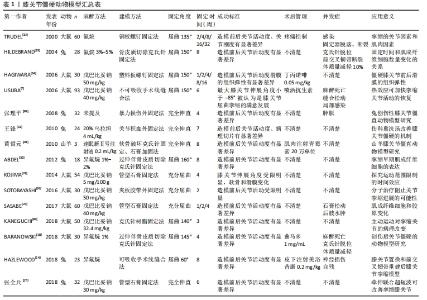
2.1.1 手术方法 关节外损伤固定:通过手术方式固定膝关节是造成关节僵硬的常用方式,采用不危及关节面的股骨-胫骨固定,可以模拟关节外骨折引起的继发性关节僵硬。USUBA等[7]使用不可吸收编织聚酯手术线和手术针进行股胫皮下结扎,将膝关节制动约150°,5周后取得膝关节屈曲挛缩的满意模型。武蒙[8]垂直于股骨和胫骨长轴打孔,使用缝合线在膝关节表面形成一个交叉,使膝关节处于充分伸直位,4周后成功获得伸直型膝关节僵硬模型。TRUDEL等[9]用螺钉和钢板连接大鼠的股骨近端和胫骨远端,钢板的走行不侵犯膝关节,使膝关节固定在屈曲135°的位置,8周后取出螺钉和钢板,造成膝关节僵硬模型。KANEGUCHI等[10-11]用克氏针穿过股骨和胫骨,然后使用钢丝和树脂固定克氏针,不损伤膝关节,使膝关节屈曲固定约140°,3周后实验组成功复制关节僵硬模型。后来也有学者使用钢丝和牙托粉在体外将克氏针固定于理想位置[12]。ZHOU等[13-14]将大鼠膝关节使用跨越股骨近端和胫骨远端的钢板和螺钉以45°屈曲角固定不同时间,以观察不同固定时间及再活动对关节活动范围的影响。 关节囊、韧带、软骨和半月板等关节内结构和关节周围的肌肉、肌腱、皮肤等关节外结构的损伤都可能导致膝关节僵硬的发生和发展。关节外损伤固定造模的方式主要是通过克氏针或钢板将股骨和胫骨连接固定起来,只对动物下肢造成骨损伤,不波及关节囊、关节软骨等关节内结构,减少了手术操作中对膝关节周围软组织的损伤,减少手术操作因素对膝关节僵硬模型结果的影响。在研究膝关节僵硬所涉及的关节软骨、关节囊及韧带等关节内部结构的病理变化过程有较大的优势。此种方法建立的模型优点是与人体股骨、胫骨不波及关节面的骨折引起膝关节僵硬原理相似,此类模型更适用于研究非膝关节关节面骨折或由于骨折制动、固定而引起的膝关节功能障碍。 关节内损伤固定:通过在股骨髁建立皮质窗并损伤关节囊,建立创伤性关节损伤,同时使用内固定的方式建立膝关节僵硬模型。这种创伤性膝关节僵硬模型具有较好的稳定性,是目前常用的模型[15],FUKUI等[16]认为这种方法造成的关节内骨破坏及关节内积血对关节僵硬起着重要的作用。传统的关节内创伤方法主要是切除膝关节股骨髁部分骨质并固定膝关节。BARLOW等[17]在家兔膝关节建立皮质窗的同时,增加了一个关节囊损伤,并用克氏针内固定8周,建立了兔创伤性膝关节僵硬模型,与对侧对照膝关节活动度相比,统计学差异具有显著性。 BARANOWSKI等[18]对30只大鼠行手术干预,将膝过伸损伤关节囊,手术使股骨髁外缺损,克氏针穿针直到膝关节屈曲达到145°位置固定4周,建立早期创伤性大鼠膝关节屈曲型挛缩模型。王飞等[19]通过在大鼠右侧股骨外髁建立皮质窗,并用克氏针将膝关节固定在伸直位,4周后成功建立膝关节伸直型僵硬的模型。黄哲元等[20]将手术步骤简化,直接在山羊膝关节上下关节面对称各钻4个骨洞,克氏针交叉固定膝关节于伸直位,并用管型长腿石膏加强固定,结果显示固定8周和12周均出现严重的膝关节僵直,在解除固定后发现僵硬度具有持久性。 MONUMENT等[21]在成年新西兰白兔中,采用关节内损伤和关节内固定相结合的方法造成膝关节创伤后僵硬。通过从股骨内外侧髁的非关节软骨部分切除双侧5 mm×5 mm皮质窗,克氏针穿过胫骨和膝关节将膝关节固定于屈曲150°,研究发现该兔膝关节僵硬模型的关节活动度丧失是不可逆的,证明此方法可以有效建立膝关节僵硬模型。有研究结果表明,通过股骨髁开窗与克氏针内固定制动时,伴有后囊损伤会导致更严重和永久的关节挛缩[22-23]。现有的膝关节挛缩的动物模型大多是用克氏针、钢板等固定,这通常需要第二次手术才能取出内固定,HAZLEWOOD等[24]通过一次手术建立了一种中度膝关节挛缩模型,实验直接损伤兔膝关节关节后囊,并从股二头肌远端剥离出肌瓣,向胫骨上段外侧牵拉与腓肠肌外侧头浅层用可吸收缝合线缝合,使膝关节处于约60°的屈曲位,该模型8周后其膝关节挛缩的严重程度与全膝关节置换和前交叉韧带重建后在人类患者中观察到的挛缩相似。 单纯的克氏针固定后形成的膝关节僵硬虽然能够产生稳定的关节挛缩,但不能完全模拟人的创伤性膝关节僵硬的机制,短时间的制动经过再运动其膝关节的活动范围可以恢复到自然状态,无法形成与人膝关节相似的永久的关节僵硬。关节内损伤固定的方式在造模时使膝关节过伸45°损伤关节后囊,并在股骨外髁的非软骨面开一个皮质窗,这种破坏关节内结构的方式造成膝关节内积血,这种创伤模拟了稳定的关节内骨折。有研究表明,这种关节源性的损伤在固定后形成的关节僵硬模型与非创伤性模型相比,更适合用于早期关节源性挛缩的创建[18]。此模型在破坏关节后囊时对交叉韧带的损伤以及可能存在的骨关节炎,会产生与关节僵硬不同的病理生理过程,这个过程在实际上可能更准确地反映临床情况。总的来说,虽然通过创伤加制动的方式所建立的膝关节僵硬模型会造成膝关节广泛的关节组织损伤,制作难度以及创伤较大,但此模型的诱导成功率高,稳定性好,并且符合关节内骨折术后形成的关节僵硬的病理特征,具有更好的临床相关性,是目前膝关节僵硬模型最常用的造模方法。 2.1.2 非手术方法 单纯外固定:通过在动物膝关节外进行固定形成膝关节僵硬。SASABE等[25]将大鼠在麻醉下放置管形石膏,双后肢膝关节充分屈曲下固定1,2,4周,研究表明制动组各时间点伸膝活动度明显减小,并呈时间依赖性明显下降,制动所致关节挛缩随制动时间的延长而发展和进展。SOTOBAYASHI等[26]用夹板和胶带外固定小鼠单侧膝关节,研究缺氧诱导因子1的转录激活与制动动物膝关节的关节活动度的关系,提出在物理治疗干预前对制动引起的关节挛缩进行基因治疗的可能性。张全兵[27]将兔的膝关节伸直,从骨盆到足趾近端通过石膏外固定,6周后建立兔膝关节伸直型僵硬模型。KOJIMA等[28]将大鼠采用石膏托全屈曲位固定单侧膝关节4周,石膏从骨盆带延伸至踝关节,髋关节最大伸展,膝关节最大屈曲,踝关节最大跖屈,4周后膝关节活动度明显受限。YUN等[29]通过将32只大白兔的膝关节维持在完全伸展的石膏托中,分别于石膏固定后2,4,6,8周观察关节活动受限进展和随后的关节囊变化,结果表明关节挛缩的严重程度在前6周进展迅速,然后可能进展较慢。 石膏或夹板外固定需要注意操作中固定的松紧程度,绷带过紧可能会使固定肢体血液循环障碍,导致肢体肿胀,绷带过松会使固定不稳导致石膏或夹板的脱落,同时石膏的质量和夹板的长度可能会影响动物的活动或发生撕咬等情况。同时石膏固定需要定时检查肢体状况,至少两三天更换1次,以防止松动和肢体水肿,如在固定中发现松动和水肿,则需要重复固定。在外固定过程中还需要注意骨性凸起部位的保护,可以在突起部位放置衬垫,防止压伤。使用单纯外固定的造模方式避免了手术操作对膝关节造成的损伤,并且石膏、夹板、绷带等材料获取简单方便,固定的操作过程较手术方法简单,与临床上下肢损伤后石膏固定类似,可以很好地模拟由于制动造成的膝关节僵硬的病理发展。但这种石膏外固定的时间较长,固定关节周围易发生肿胀、肢体远端血液循环障碍等并发症。由于实验动物肢体较短、依从性较差,石膏固定不牢靠、经常发生动物啃咬等情况,易造成固定失败。 暴力损伤后外固定:张理平等[30]为了研究中药敷药对膝关节僵硬的治疗效果,对大白兔的右后肢膝关节进行强力的顺时针和逆时针2个方向的扭转各20次(不使关节脱位为度),并强力揉按膝关节周围软组织20次,连续操作4 d后将膝关节以石膏绷带固定于伸直位,对其皮温、肿胀度以及血液流变学等进行检测,4周后患肢屈伸功能明显障碍,X射线片、血液流变学部分指标均出现与创伤性膝关节僵硬的表现一致的变化,表明膝关节僵硬模型复制成功。王锋等[31]向家兔右膝关节腔内注射自身血液2 mL,以形成全关节积血,再以管型石膏伸直位固定7周,成功复制伸直型膝关节僵硬动物模型。 暴力损伤、强力按摩等损伤方式目前还没有一个量化的标准,在人为操作的过程中,每次的手法、方向与力量都难以统一,会造成损伤的差异性,影响实验结果的发生发展。自身血液注射可以模拟损伤后关节内血性渗出物积存,血液进淋巴循环受阻,组织增生引起的膝关节僵硬,但由于其血液的吸收在个体的差异较大,此方法的使用较少。暴力损伤造成膝关节周围软组织局部损伤出血,可以较好地模拟膝关节周围软组织损伤制动后形成的膝关节僵硬的病理变化过程,此模型在研究膝关节周围软组织损伤后的关节僵硬的中医中药治疗中具有良好的优势。 目前研究者主要采用手术方法和非手术方法进行造模[32-36]。TRUDEL,HILDEBRAND,HAGIWARA此3位学者建立的动物模型方法的影响最大[32-34],近年来膝关节僵硬模型的建立多在以往研究的造模基础上进行改良,手术的方式以及固定方式都有不同的进步,更加稳定地建立了膝关节僵硬的发生、发展的模型,为其机制以及治疗的研究实现了新的突破。 作者总结了2006-2018年有关膝关节僵硬动物模型特点文章,见表1。"
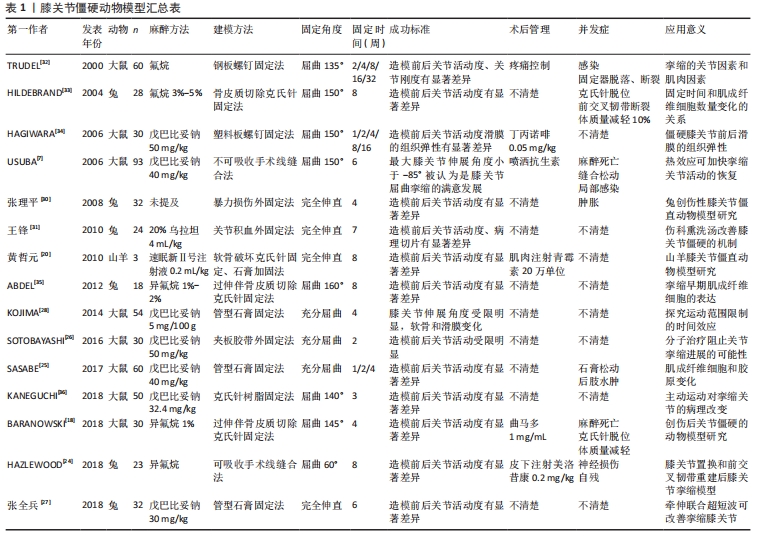
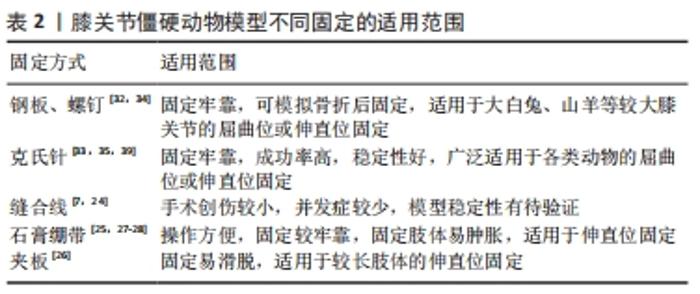
在以往文献报道中构建膝关节僵硬模型过程中膝关节的固定方式主要有钢板-螺钉内固定、克氏针内固定和石膏绷带固定等[12,19,32-34,37],不同的固定方式都有一定的适用范围,在选择时要根据需要选取最佳的固定方式。手术内固定的模型手术要求高、操作复杂,创伤较大,易感染,但稳定性好、造模时间短,在膝关节僵硬的造模中应用最为广泛。石膏绷带、夹板等外固定操作简单方便,但在动物运动过程中易松动、脱滑,或发生啃咬等现象,造模时间较长,固定易失败。克氏针、钢板及石膏等的刚性固定可能产生较大的机械应力,易发生术后骨折。有证据表明单纯关节制动其生物学变化仍可能被逆转,正常动物单纯关节制动后发生的关节僵硬不能模拟人关节周围和关节内损伤后可能发生的永久性僵硬[32,38]。随着技术的发展,固定方式也逐渐改 进[7,24-28, 32-35,39],不同固定方式的适用范围,见表2。"
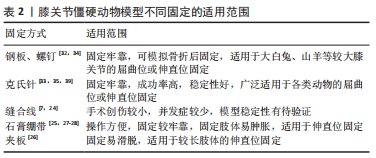
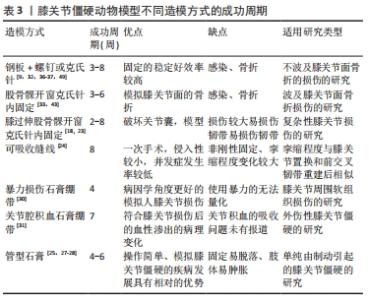
2.3 不同固定时间对关节僵硬的影响 据报道,在关节固定2周后,关节周围软组织(韧带、关节囊等)中的生化和形态学发生变化,关节僵硬没有增加,当固定时间延长至6周时,膝关节僵硬增加明显[25,40]。并且有研究者发现即使短期的固定也会造成不可逆的关节软骨损伤[41-43]。ZHOU等[13]将大鼠分为6个不同的制动时间:1,2,4,8,16和32周,实验发现固定4周膝关节活动度受限明显,随着制动时间的增加,关节活动度丢失增加不明显,膝关节僵硬度显著增加。引起固定性关节挛缩的结构主要分为肌肉(肌肉、肌腱、筋膜)和关节(骨软骨、韧带)2个因素。 短期(2周内)固定引起的关节挛缩主要是肌源性的,而长期(2-4周以上)固定主要是关节源性的[11]。通过离断膝关节周围肌肉前后所测得的活动度进行比较,不同的固定时间所产生的关节功能的变化,主要是由于肌源性与关节源性因素之间的关系。关节活动度的限制与僵硬度的增加之间的差异是由于短期制动相关的肌肉限制和长期制动期间的关节限制(如关节囊和韧带)[44-45]。因此,短期的制动引起的关节活动度限制是由于肌肉因素,而长期制动会引起关节结构的变化,从而引起受限角度下的僵硬度增加。王锋[46]发现膝关节总挛缩与肌源性挛缩随着固定时间的延长而有所变化,总挛缩在固定第6周后趋于稳定,但肌源性挛缩程度在固定第2周后趋于稳定。关节僵硬程度、肌肉限制与关节限制比例均与固定时间有着密切的关系。 2.4 固定角度的确定 在膝关节角度固定时,文献中建立屈曲型膝关节僵硬描述的角度多为屈曲135°,145°,150°或完全屈 曲[18,32-33],也有描述为股骨与胫骨之间的角度45°[12],部分建立伸直型膝关节僵硬的固定角度为完全伸直。在手术固定时,克氏针的进针位置或钢板螺钉的位置根据动物股骨和胫骨的实际情况进行调整,通常情况在操作时根据股骨纵轴线、腓骨头与外踝尖的连线,角度尺中心置于股骨外侧髁,这两条线所形成的夹角来判定膝关节固定的屈曲角度(股骨与胫骨形成的夹角),由于操作的不确定性以及动物的生理构造,在实际的测量中也会有一定的误差。在选择固定角度时应根据动物类型以及其骨头大小来进行调整,股骨与胫骨之间的夹角越小,由于内固定的应力和剪切力的作用,发生骨折的可能性会增加。 2.5 模型动物种类的选择 动物模型的选择原则为相关性、适当性和实用性。结合动物的特点和疾病的特征、实验目的与具体情况来选择动物模型是实验成功的重要保证,根据目前对膝关节僵硬动物模型的建立情况,小鼠、大鼠、大白兔、山羊和狗是常用的动物[15,20,32-33,47-48]。其中山羊、狗的膝关节解剖结构与人膝关节具有较高的相似度,关节较大可较清晰地观察关节内组织结构以及生物力学变化,同时其自然位置处于伸直位,是理想的伸直型膝关节僵直动物模型,但这些动物花费成本较高,不易进行大规模实验。小鼠的膝关节结构小、组织少、软骨薄,无论是手术方式还是非手术方式,膝关节的固定都有极大的难度,并且针对小鼠膝关节后期的术后护理、干预治疗都有很大的困难,目前使用较少。大鼠、兔的膝关节相对较经济易得,其膝关节同样具有与人膝关节相似的组织结构,可手术、药物干预[49],在膝关节动物模型研究中应用较广,是观察膝关节结构病理变化、膝关节生物力学、药效评价及其作用机制研究的理想动物,目前应用广泛。 2.6 造模方式及成功周期 膝关节僵硬动物模型的建立通过手术创伤+固定或非手术外固定的方式来造成关节活动度的丧失,以造成或不造成关节结构的破坏来模拟不同损伤引起的膝关节僵硬。造模的方式不同成功所需要的时间有所差异。最理想的膝关节僵硬造模方式为膝过伸+关节内手术创伤+固定,通过膝过伸损伤关节后囊、在股骨髁开窗模拟关节内骨折,采用克氏针内固定的方式进行造模,固定4周,此方法建模时间短、成功率高。非手术方式中石膏固定需要密切关注固定的松紧度以及固定肢体的血液循环,发现动物的撕咬和脱落情况及时更换,此方法形成关节僵硬模型的耗时较长。模拟不同的损伤造成的关节僵硬也有最适用的造模方式,需要根据预期的实验设计类型来选择合适的造模方法。不同造模方式的成功周期,见表3。"
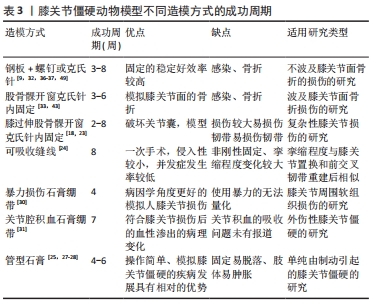
| [1] 王璐,张立宁,何家乐,等.不同时长的静态进展性牵伸对大鼠创伤性膝关节挛缩的治疗效果及其机制研究[J].四川大学学报(医学版),2020,51(2):182-192. [2] CHEN AF, LEE YS, ADAM J, et al. Arthrofibrosis and large joint scarring. Connect Tissue Res. 2019;60(1):21-28. [3] 关骅.中国骨科康复学[M].北京:人民军医出版社,2011. [4] YERCAN HS, SUGUN TS, BUSSIERE C, et al. Stiffness after total knee arthroplasty: prevalence, management and outcomes. Knee. 2006; 13(2):111-117. [5] CANADIAN ORTHOPAEDIC TRAUMA SOCIETY. Open reduction and internal fixation compared with circular fixator application for bicondylar tibial plateau fractures. Results of a multicenter, prospective, randomized clinical trial. J Bone Joint Surg Am. 2006;88(12):2613-2623. [6] 夏冬瑞,颜继英,张学斌,等.胫骨平台骨折术后膝关节僵硬的发生率及危险因素分析[J].中国骨与损伤杂志,2019,34(12):1315-1317. [7] USUBA M, MIYANAGA Y, MIYAKAWA S, et al. Effect of heat in increasing the range of knee motion after the development of a joint contracture: an experiment with an animal model. Arch Phys Med Rehabil. 2006; 87(2):247-253. [8] 武蒙.体外冲击波在大鼠膝关节僵硬治疗中的应用及其作用机制的研究[D].沈阳:中国医科大学,2020. [9] TRUDEL G, ZHOU J, UHTHOFF HK, et al. Four weeks of mobility after 8 weeks of immobility fails to restore normal motion: a preliminary study. Clin Orthop Relat Res. 2008;466(5):1239-1244. [10] KANEGUCHI A, OZAWA J, KAWAMATA S, et al. Development of arthrogenic joint contracture as a result of pathological changes inremobilized rat knees. J Orthop Res. 2017;35(7):1414-1423. [11] KANEGUCHI A, OZAWA J, MINAMIMOTO K, et al. Morphological and biomechanical adaptations of skeletal muscle in the recovery phase after immobilization in a rat. Clin Biomech (Bristol, Avon). 2020;75: 104992. [12] 古哈尔·艾思拉洪.综合康复护理干预对关节挛缩动物模型形态学及血流动力影响[D].乌鲁木齐:新疆医科大学,2020. [13] ZHOU HD, TRUDEL G, GOUDREAU L, et al. Knee joint stiffness following immobilization and remobilization: a study in the rat model. J Biomech. 2020;99:109471. [14] ZHOU HD, TRUDEL G, LANEUVILLE O. Mechanical adaptation of synoviocytes A and B to immobilization and remobilization: a study in the rat knee flexion model. J Mol Histol. 2020;51(5):605-611. [15] BARLOW JD, HARTZLER RU, ABDEL MP, et al. Surgical capsular release reduces flexion contracture in a rabbit model of arthrofibrosis. J Orthop Res. 2013;31(10):1529-1532. [16] FUKUI N, FUKUDA A, KOJIMA K, et al. Suppression of fibrous adhesion by proteoglycan decorin. J Orthop Res. 2001;19(3):456-462. [17] BARLOW JD, MORREY ME, HARTZLER RU, et al. Effectiveness of rosiglitazone in reducing flexion contracture in a rabbit model of arthrofibrosis with surgical capsular release: a biomechanical, histological, and genetic analysis. Bone Joint Res. 2016;5(1):11-17. [18] BARANOWSKI A, SCHLEMMER L, FÖRSTER K, et al. A novel rat model of stable posttraumatic joint stiffness of the knee. J Orthop Surg Res. 2018;13(1):185. [19] 王飞,刘克敏,刘四海.康复治疗对创伤后膝关节僵直活动度及肌肉组织的影响[J].中国矫形外科杂志,2017,25(6):534-538. [20] 黄哲元,袁志,卫磊.山羊膝关节僵直动物模型的建立[J].创伤外科杂志,2010,12(2):159-162. [21] MONUMENT MJ, HART DA, BEFUS AD, et al. The mast cell stabilizer ketotifen fumarate lessens contracture severity and myofibroblast hyperplasia: a study of a rabbit model of posttraumatic joint contractures. J Bone Joint Surg Am. 2010;92(6):1468-1477. [22] NESTERENKO S, MORREY S, ABDEL MP, et al. New rabbit knee model of post-traumatic joint contracture: indirect capsular damage induces a severe contracture. Orthop Res. 2009;27(8):1028-1032. [23] BARANOWSKI A, SCHLEMMER L, FÖRSTER K, et al. Effects of losartan and atorvastatin on the development of early posttraumatic joint stiffness in a rat model. Drug Des Devel Ther. 2019;13:2603-2618. [24] HAZLEWOOD D, FENG Y, LU QH, et al. Novel rabbit model of moderate knee contracture induced by direct capsular damage. J Orthop Res. 2018;36(10):2687-2695. [25] SASABE R, SAKAMOTO J, GOTO K, et al. Effects of joint immobilization on changes in myofibroblasts and collagen in the rat knee contracture model. J Orthop Res. 2017;35(9):1998-2006. [26] SOTOBAYASHI D, KAWAHATA H, ANADA N, et al. Therapeutic effect of intra-articular injection of ribbon-type decoy oligonucleotides for hypoxia inducible factor-1 on joint contracture in an immobilized knee animal model. J Gene Med. 2016;18(8):180-192. [27] 张全兵.牵伸联合超短波治疗对兔膝关节挛缩模型中关节功能恢复以及关节囊纤维化影响的初步研究[D].合肥:安徽医科大学, 2018. [28] KOJIMA S, HOSO M, WATANABE M, et al. Experimental joint immobilization and remobilization in the rats. J Phys Ther Sci. 2014; 26(6):865-871. [29] YUN Z, QUANBING Z, HUAZHANG Z, et al. Rabbit model of extending knee joint contracture: progression of joint motion restriction and subsequent joint capsule changes after immobilization. J Knee Surg. 2020;33(1):15-21. [30] 张理平,刘晓颖,林绍彬,等.创伤性膝关节僵直动物模型的研究[J].中国中医骨伤科杂,2008,16(5):25-27. [31] 王锋,徐勇,夏云建.外伤性膝关节僵硬模型兔中药熏洗治疗后内侧副韧带组织中糖胺聚糖的表达[J].中国组织工程研究与临床康复,2010,14(46):8631-8634. [32] TRUDEL G, UHTHOFF HK. Contractures secondary to immobility: is the restriction articular or muscular? An experimental longitudinal study in the rat knee. Arch Phys Med Rehabil. 2000;81(1):6-13. [33] HILDEBRAND KA, SUTHERLAND C, MEI Z. Rabbit knee model of post-traumatic joint contractures: the long-term natural history of motion loss and myofibroblasts. J Orthop Res. 2004;22(8):313-320. [34] HAGIWARA Y, SAIJO Y, CHIMOTO E, et al. Increased elasticity of capsule after immobilization in a rat knee experimental model assessed by scanning acoustic microscopy. Ups J Med Sci. 2006;111(3):303-313. [35] ABDEL MP, MORREY ME, BARLOW JD, et al. Myofibroblast cells are preferentially expressed early in a rabbit model of joint contracture. J Orthop Res. 2012;30(5):713-719. [36] KANEGUCHI A, OZAWA J, YAMAOKA K. Anti-inflammatory drug dexamethasone treatment during the remobilization period improves range of motion in a rat knee model of joint contracture. Inflammation. 2018;41(4):1409-1423. [37] WONG K, TRUDEL G, LANEUVILLE O. Intra-articular collagenase injection increases range of motion in a rat knee flexion contracture model. Drug Des Devel Ther. 2017;12:15-24. [38] HAGIWARA Y, ANDO A, CHIMOTO E, et al. Expression of collagen types i and ii on articular cartilage in a rat knee contracture model. Connect Tissue Res. 2010;51(1):22-30. [39] NAGAI M, AOYAMA T, ITO A, et al. Contributions of biarticular myogenic components to the limitation of the range of motion after immobilization of rat knee joint. BMC Musculoskelet Disord. 2014;15: 224. [40] KANEGUCHI A, OZAWA J, MINAMIMOTO K, et al. Active exercise on immobilization-induced contractured rat knees develops arthrogenic joint contracture with pathological changes. J Appl Physiol. 2018; 124(2):291-301. [41] ANDO A, SUDA H, HAGIWARA Y, et al. Reversibility of immobilization-induced articular cartilage degeneration after remobilization in rat knee joints. Tohoku J Exp Med. 2011;224(2):77-85. [42] NAGAI M, ITO A, TAJINO J, et al. Remobilization causes site-specific cyst formation in immobilization-induced knee cartilage degeneration in an immobilized rat model. J Anat. 2016;228(6):929-939. [43] HAGIWARA Y, ANDO A, CHIMOTO E, et al. Changes of articular cartilage after immobilization in a rat knee contracture model. J Orthop Res. 2009;27(2):236-242. [44] TRUDEL G, LANEUVILLE O, COLETTA E, et al. Quantitative and temporal differential recovery of articular and muscular limitations of knee joint contractures: results in a rat model. J Appl Physiol. 2014;117(7):730-737. [45] TRUDEL G, UHTHOFF HK, GOUDREAU L, et al. Quantitative analysis of the reversibility of knee flexion contractures with time: an experimental study using the rat model. BMC Musculoskelet Disord. 2014;15:338. [46] 王锋.超短波对兔伸直型膝关节挛缩模型中关节功能障碍和废用性肌萎缩治疗作用的初步研究[D].合肥:安徽医科大学,2019. [47] HAGIWARA Y, ANDO A, ONODA Y, et al. Expression patterns of collagen types i and iii in the capsule of a rat knee contracture model. J Orthop Res. 2010;28(3):315-321. [48] OAKLEY SP, LASSERE MN, PORTEK I, et al. Biomechanical histologic and macroscopic assessment of articular cartilage in a sheep model of osteoarthritis. Osteoarthritis Cartilage. 2004;12(8):667-679. [49] OZAWA J, KANEGUCHI A, TANAKA R, et al. Cyclooxygenase-2 inhibitor celecoxib attenuates joint contracture following immobilization in rat knees. BMC Musculoskelet Disord. 2016;17(1):446. |
| [1] | Wang Jianping, Zhang Xiaohui, Yu Jinwei, Wei Shaoliang, Zhang Xinmin, Xu Xingxin, Qu Haijun. Application of knee joint motion analysis in machanism based on three-dimensional image registration and coordinate transformation [J]. Chinese Journal of Tissue Engineering Research, 2022, 26(在线): 1-5. |
| [2] | Tan Xinfang, Guo Yanxing, Qin Xiaofei, Zhang Binqing, Zhao Dongliang, Pan Kunkun, Li Yuzhuo, Chen Haoyu. Effect of uniaxial fatigue exercise on patellofemoral cartilage injury in a rabbit [J]. Chinese Journal of Tissue Engineering Research, 2022, 26(在线): 1-6. |
| [3] | Zhang Jichao, Dong Yuefu, Mou Zhifang, Zhang Zhen, Li Bingyan, Xu Xiangjun, Li Jiayi, Ren Meng, Dong Wanpeng. Finite element analysis of biomechanical changes in the osteoarthritis knee joint in different gait flexion angles [J]. Chinese Journal of Tissue Engineering Research, 2022, 26(9): 1357-1361. |
| [4] | Wu Liang, Wang Qiang, Wang Wenbo, Xin Tianwen, Xi Kun, Tang Jincheng, Xu Jingzhi, Chen Liang, Gu Yong. Risk factors for traumatic central cord syndrome underlying with cervical spondylotic myelopathy [J]. Chinese Journal of Tissue Engineering Research, 2022, 26(9): 1388-1394. |
| [5] | Wang Baojuan, Zheng Shuguang, Zhang Qi, Li Tianyang. Miao medicine fumigation can delay extracellular matrix destruction in a rabbit model of knee osteoarthritis [J]. Chinese Journal of Tissue Engineering Research, 2022, 26(8): 1180-1186. |
| [6] | Lü Yiyan, Li Hanbing, Ma Xiaoqing, Zhang Han, Zhang Yuhang, Li Genlin. Establishment and characteristic analysis of interior heat and diabetes mouse model using compound factors [J]. Chinese Journal of Tissue Engineering Research, 2022, 26(8): 1187-1193. |
| [7] | Zhao Jing, Liu Xiaobo, Zhang Yue, Zhang Jiaming, Zhong Dongling, Li Juan, Jin Rongjiang. Visualization analysis of neuromuscular electrical stimulation therapy based on CiteSpace: therapeutic effects, hot spots, and developmental trends [J]. Chinese Journal of Tissue Engineering Research, 2022, 26(8): 1234-1241. |
| [8] | Zhu Chan, Han Xuke, Yao Chengjiao, Zhang Qiang, Liu Jing, Shao Ming. Acupuncture for Parkinson’s disease: an insight into the action mechanism in animal experiments [J]. Chinese Journal of Tissue Engineering Research, 2022, 26(8): 1272-1277. |
| [9] | Wu Bingshuang, Wang Zhi, Tang Yi, Tang Xiaoyu, Li Qi. Anterior cruciate ligament reconstruction: from enthesis to tendon-to-bone healing [J]. Chinese Journal of Tissue Engineering Research, 2022, 26(8): 1293-1298. |
| [10] | Wang Xinmin, Liu Fei, Xu Jie, Bai Yuxi, Lü Jian. Core decompression combined with dental pulp stem cells in the treatment of steroid-associated femoral head necrosis in rabbits [J]. Chinese Journal of Tissue Engineering Research, 2022, 26(7): 1074-1079. |
| [11] | Liu Dongcheng, Zhao Jijun, Zhou Zihong, Wu Zhaofeng, Yu Yinghao, Chen Yuhao, Feng Dehong. Comparison of different reference methods for force line correction in open wedge high tibial osteotomy [J]. Chinese Journal of Tissue Engineering Research, 2022, 26(6): 827-831. |
| [12] | Shao Yangyang, Zhang Junxia, Jiang Meijiao, Liu Zelong, Gao Kun, Yu Shuhan. Kinematics characteristics of lower limb joints of young men running wearing knee pads [J]. Chinese Journal of Tissue Engineering Research, 2022, 26(6): 832-837. |
| [13] | Huang Hao, Hong Song, Wa Qingde. Finite element analysis of the effect of femoral component rotation on patellofemoral joint contact pressure in total knee arthroplasty [J]. Chinese Journal of Tissue Engineering Research, 2022, 26(6): 848-852. |
| [14] | Yuan Jing, Sun Xiaohu, Chen Hui, Qiao Yongjie, Wang Lixin. Digital measurement and analysis of the distal femur in adults with secondary knee valgus deformity [J]. Chinese Journal of Tissue Engineering Research, 2022, 26(6): 881-885. |
| [15] | Zhou Jianguo, Liu Shiwei, Yuan Changhong, Bi Shengrong, Yang Guoping, Hu Weiquan, Liu Hui, Qian Rui. Total knee arthroplasty with posterior cruciate ligament retaining prosthesis in the treatment of knee osteoarthritis with knee valgus deformity [J]. Chinese Journal of Tissue Engineering Research, 2022, 26(6): 892-897. |
| Viewed | ||||||
|
Full text |
|
|||||
|
Abstract |
|
|||||



